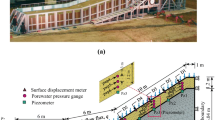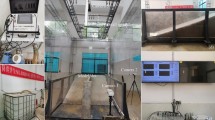Abstract
The main aim of this paper is to define an elastic wave velocity threshold for rainfall-induced landslide prediction and early warning. To achieve this goal, several key questions need to be addressed, such as what threshold of wave velocity should be employed for issuing early warning? And how such thresholds should be selected? In an attempt to answer these questions, a total of 32 centrifuge experiments were conducted on model slopes. We first determined the critical deformation prior to initiation of shear failure. Then, the corresponding wave velocities at the critical deformation were compiled to establish a threshold of wave velocity to be used for early warning of landslides. Finally, a large-scale slope model test was performed to confirm the proposed threshold of elastic wave velocity. Based on the wave monitoring results, a warning is proposed to be issued at normalized elastic wave velocity of 0.9, and the slope toe is preferable for wave monitoring.













Similar content being viewed by others
References
Baum RL, Godt JW (2010) Early warning of rainfall-induced shallow landslides and debris flows in the USA. Landslides 7(3):351–357
Cai QP, Ng CWW (2013) Boundary effects on ground surface rupture induced by normal faulting. Can Geotech J 50:413–422
Cai QP, Ng CWW (2014) Effects of the tip depth of a pre-existing fracture on surface fault ruptures in cemented clay. Comput Geotech 56:181–190
Cai QP, Ng CWW (2016) Centrifuge modeling of pile-sand interaction induced by normal faulting. J Geotech Geoenviron 142(10):04016046
Cai QP, Ng CWW, Hu P (2015) Boundary effects on ground surface rupture induced by normal faulting. Géotech Lett 5(3):161–166
Cai QP, Ng CWW, Chen XX, Guo LQ, Su SZ (2018) Effects of cementation on pore water pressure response during normal faulting in clay. Géotech Lett 8(1):56–60
Capparelli G, Tiranti D (2010) Application of the MoniFLaIR early warning system for rainfall-induced landslides in Piedmont region (Italy). Landslides 7(4):401–410
Chen Y, Uchimura T, Irfan M, Huang D, Xie J (2017) Detection of water infiltration and deformation of unsaturated soils by elastic wave velocity. Landslides 14(5):1715–1730. https://doi.org/10.1007/s10346-017-0825-8
Chen YL, Irfan M, Uchimura T, Cheng GW, Nie W (2018a) Elastic wave velocity monitoring as an emerging technique for rainfall-induced landslide prediction. Landslides 15(6):1155–1172
Chen YL, Irfan M, Uchimura T, Zhang K (2018b) Feasibility of using elastic wave velocity monitoring for early warning of rainfall-induced slope failure. Sensors 18:997. https://doi.org/10.3390/s18040997
Eab KH, Likitlersuang S, Takahashi A (2015) Laboratory and modelling investigation of root-reinforced system for slope stabilisation. Soils Found 55(5):1270–1281
Irfan M, Uchimura T (2018) Development and performance evaluation of disk type piezoelectric transducer for measurement of shear and compression wave velocities in soil. J Earthq Eng 22(1):147–171. https://doi.org/10.1080/13632469.2016.1217800
Irfan M, Uchimura T, Chen Y (2017) Effects of soil deformation and saturation on elastic wave velocities in relation to prediction of rain-induced landslides. Eng Geol 230:84–94
Lagomarsino D, Fanti R, Catani F (2013) Updating and tuning a regional-scale landslide early warning system. Landslides 10(1):91–97
Liao Z, Hong Y, Wang J, Fukuoka H, Sassa K, Karnawati D, Fathani F (2010) Prototyping an experimental early warning system for rainfall-induced landslides in Indonesia using satellite remote sensing and geospatial datasets. Landslides 7(3):317–324
Loew S, Gschwind S, Gischig V, Keller-Signer A, Valenti G (2017) Monitoring and early warning of the 2012 Preonzo catastrophic rockslope failure. Landslides 14:141–154
Ministry of Land Infrastructure and Transport, Japan (2013) Report of the damage caused by heavy rainfall during the typhoon no. 26 (no. 16). http://www.bousai.go.jp/updates/h25typhoon26/pdf/h25typhoon26_16.pdf. Accessed 4 Feb 2014
Mirus BB, Becker RE, Baum RL, Smith JB (2018) Integrating real-time subsurface hydrologic monitoring with empirical rainfall thresholds to improve landslide early warning. Landslides 15:1909–1919. https://doi.org/10.1007/s10346-018-0995-z
Orense RP, Towhata I, Farooq K (2003) Investigation of failure of sandy slopes caused by heavy rainfall. In: Proc. Int. Conf. on Fast Slope Movement—Prediction and Prevention for Risk Mitigation (FSM2003), Sorrento
Orense RP, Farooq K, Towhata I (2004a) Deformation behavior of sandy slopes during rainwater infiltration. Soil Found 44(2):15–30
Orense RP, Shimoma S, Maeda K, Towhata I (2004b) Instrumented model slope failure due to water seepage. J Nat Dis Sci 26(1):15–26
Palladino MR, Viero A, Turconi L, Brunetti MT, Peruccacci S, Melillo M, Luino F, Deganutti AM, Guzzetti F (2018) Rainfall thresholds for the activation of shallow landslides in the Italian Alps: the role of environmental conditioning factors. Geomorphology 303:53–67
Piciullo L, Gariano SL, Melillo M, Brunetti MT, Peruccacci S, Guzzetti F, Calvello M (2017) Definition and performance of a threshold-based regional early warning model for rainfall-induced landslides. Landslides 14(3):995–1008
Sharma RH, Nakagawa H (2010) Numerical model and flume experiments of single- and two-layered hillslope flow related to slope failure. Landslides 7:425–432
Thiebes B, Bell R, Glade T, Jäger S, Mayer J, Anderson M, Holcombe L (2014) Integration of a limit-equilibrium model into a landslide early warning system. Landslides 11(5):859–875
Towhata I (2008) Geotechnical earthquake engineering. Springer, Berlin Heidelberg
Towhata I, Uchimura T, Seko I, Wang L (2015) Monitoring of unstable slopes by MEMS tilting sensors and its application to early warning. International Symposium on Geohazards and Geomechanics (ISGG2015) 26:012049. https://doi.org/10.1088/1755-1315/26/1/012049
Uchimura T, Towhata I, Lan Anh T, Fukuda J, Bautista CB, Wang L, Seko I, Uchida T, Matsuoka A, Ito Y, Onda Y, Iwagami S, Kim MS, Sakai N (2010) Simple monitoring method for precaution of landslides watching tilting and water contents on slopes surface. Landslides 7(3):351–357
Uchimura T, Towhata I, Wang L, Nishie S, Yamaguchi H, Seko I, Qiao JP (2015) Precaution and early warning of surface failure of slopes using tilt sensors. Soils Found 55(5):1086–1099
Weng MC, Chen TC, Tsai SJ (2017) Modeling scale effects on consequent slope deformation by centrifuge model tests and the discrete element method. Landslides 14(3):981–993
Zhang G, Qian JY, Wang R, Zhang JM (2011) Centrifuge model test study of rainfall-induced deformation of cohesive soil slopes. Soils Found 51(2):297–305
Zhang G, Wang R, Qian JY, Zhang JM, Qian JG (2012) Effect study of cracks on behavior of soil slope under rainfall conditions. Soils Found 52(4):634–643
Acknowledgements
The first author would like to acknowledge the Japanese Government (MONBUKAGAKUSHO: MEXT) Scholarship for his Ph.D. scholarship during his study. The study is supported by the China Postdoctoral Science Foundation (2017M620048 and 2018T110103).
Author information
Authors and Affiliations
Corresponding authors
Appendix
Rights and permissions
About this article
Cite this article
Chen, Y., Irfan, M., Uchimura, T. et al. Development of elastic wave velocity threshold for rainfall-induced landslide prediction and early warning. Landslides 16, 955–968 (2019). https://doi.org/10.1007/s10346-019-01138-2
Received:
Accepted:
Published:
Issue Date:
DOI: https://doi.org/10.1007/s10346-019-01138-2






